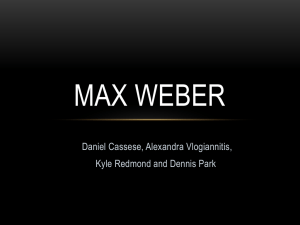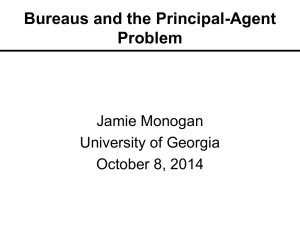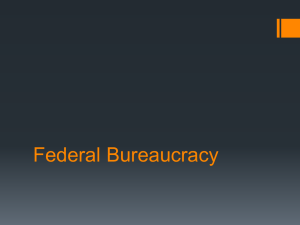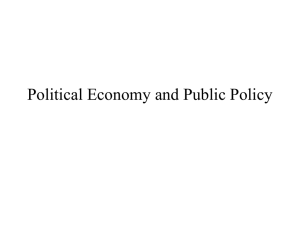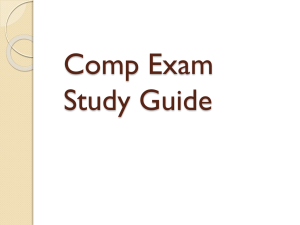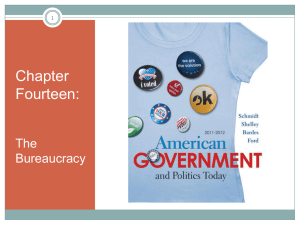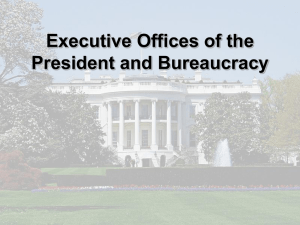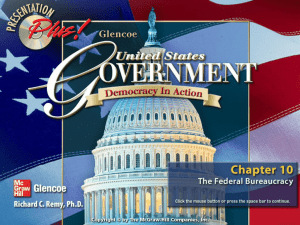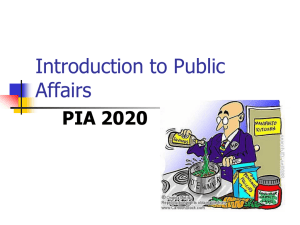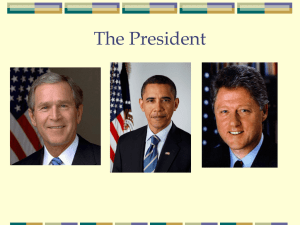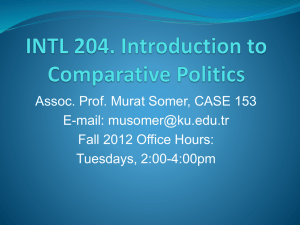LESSON 3 PAD190
advertisement
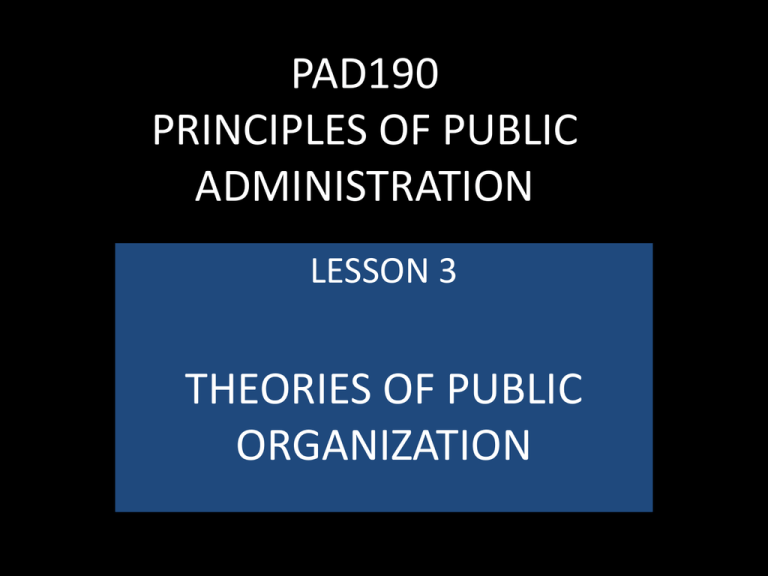
PAD190 PRINCIPLES OF PUBLIC ADMINISTRATION LESSON 3 THEORIES OF PUBLIC ORGANIZATION THE OBJECTIVES OF THIS LESSON After attended this lecture student should be able to:1. Define the concept of bureaucracy. 2. Explain the Max Weber's theory of bureaucracy 3. Explain the nature of bureaucratic organization. 4. Explain strengths and limitations of bureaucratic organization. 5. Explain publid administration as a model of bureaucracy. INTRODUCTION The study on the on the theories of public organization is focus on • the theory of bureaucracy as the foundation for the establishment of public organization. • The nature and characteristics of bureaucratic organization. • The strengths and limitations of bureaucratic organization. WHAT IS BUREAUCRACY • the word "bureaucracy" itself stems from the word "bureau", used from the early 18th century in Western Europe not just to refer to a writing desk, but to an office, i.e., a workplace, where officials worked. • A bureaucracy traditionally does not create policy but, rather, enacts it. Law, policy, and regulation normally originates from a leadership, which creates the bureaucracy to put them into practice. DEFINITION • Definition: A bureaucracy is a form of organization in which officeholders have defined positions and (usually) titles. Formal rules specify the duties of the officeholders. Personal distinctions are usually discouraged by the rules. • Bureaucracy is the collective organizational, procedures, protocols, and set of regulations in place to manage activity, usually in large organizations and government. WHO INTRODUCED THE CONCEPT • KALR MARX (1818 –1883) - Marx's theory, bureaucracy rarely creates new wealth by itself, but rather controls, co-ordinates and governs the production, distribution and consumption of wealth. The bureaucracy as a social stratum derives its income from the appropriation of part of the social surplus product of human labor. Wealth is appropriated by the bureaucracy by law through fees, taxes, levies, tributes, licensing etc. • MAX WEBER (1864 –1920) - A formal, hierarchical organization with many levels in which tasks, responsibilities, and authority are delegated among individuals, offices, or departments, held together by a central administration. According to many sociologists and anthropologists, the development of bureaucratic organizations is necessary for the emergence of any modern civilization. • According to Weber, the attributes of modern bureaucracy include its impersonality, concentration of the means of administration, a leveling effect on social and economic differences and implementation of a system of authority that is practically indestructible. THE GENERAL PRINCIPLES OF BUREAUCRACY • Clear hierarchy of authority. • Rigid division of labour. • Written and inflexible rules, regulations and procedures. • Impersonal relationship. • Once instituted, bureaucracies are difficult to dislodge or change. TYPES OF BUREAUCRACY • Representative Bureaucracy – acts as representative of citizens. The establishment of bureaucracy based on citizens ratio (race and ethnicity) to ensure the interests of diverse groups are represented in policy formulation and implementation processes. • Neutral Bureaucracy Bureaucrats are supposed to administer the rules without bias. No one should be given preferential treatment. • Political neutrality of civil service. • Work based on policy, rules and regulations An application of these principles has created a new form of bureaucratic organization and become an ideal type of organization in the government (Max Weber). THE CHARACTERISTICS OF BUREAUCRATIC ORGANIZATION 1. official business is conducted on a continuous basis 2. official business is conducted with strict accordance to the following rules: the duty of each official to do certain types of work is delimited in terms of impersonal criteria the official is given the authority necessary to carry out his assigned functions the means of coercion at his disposal are strictly limited and conditions of their use strictly defined . 3. every official's responsibilities and authority are part of a vertical hierarchy of authority, with respective rights of supervision and appeal 4. officials do not own the resources necessary for the performance of their assigned functions but are accountable for their use of these resources 5. official and private business and income are strictly separated 6. offices cannot be appropriated by their incumbents (inherited, sold, etc.) 7. official business is conducted on the basis of written documents. A bureaucratic official: • is personally free and appointed to his position on the basis of conduct . • exercises the authority delegated to him in accordance with impersonal rules, and his or her loyalty is enlisted on behalf of the faithful execution of his official duties . • appointment and job placement are dependent upon his or her technical qualifications . • administrative work is a full-time occupation . • work is rewarded by a regular salary and prospects of advancement in a lifetime career . THE STRENGTHS OF BUREAUCRACY • Prevent misused or abused of power • Rationalized and formalized decision – making a right decision based on facts. • Clear and written records - formality • Specialization of works – increase productivity. • Increase accountability and integrity – more responsible to the job. • Equal access to government services - Fair and just treatment regardless of political ideology, race or ethnicity. THE CRITICS AND LIMITATIONS OF BUREAUCRACY • Overspecialization – making individual officials not aware of larger consequences of their actions; • Rigidity and inertia of procedures - making decisionmaking slow or even impossible when facing some unusual case, and similarly delaying change, evolution and adaptation of old procedures to new circumstances; • A phenomenon of group thinking - zealotry, loyalty and lack of critical thinking regarding the organization which is perfect and always correct by definition, making the organization unable to change and realize its own mistakes and limitations; • Disregard for dissenting opinions - even when such views suit the available data better than the opinion of the majority; • As bureaucracy creates more and more rules and procedures - their complexity rises and coordination diminishes, facilitating creation of contradictory and recursive rules, as described by the saying "the bureaucracy is expanding to meet the needs of the expanding bureaucracy". • Not allowing people to use common sense - as everything must be as is written by the law. PUBLIC ADMINISTRATION AS THE MODEL OF BUREAUCRACY • Theory of bureaucracy has created an institution of public organization. • Public administration denotes the institutions of public bureaucracy within a state and governed by bureaucratic officials. • A bureaucrat is a member of public organization working to execute public policy. • All Government servants are bureaucrats in public administration. Their position is subject to law, rules, regulations and procedures. TUTORIAL DISCUSSION • • • • What is bureaucracy? What are the principles of bureaucracy? What is bureaucratic organization? What are the characteristics of bureaucratic organization? • What are the strengths and limitations of bureaucratic organization. • How public organization denotes the institutions of bureaucratic organization? THAT ALL FOR TODAY SEE YOU AGAIN NEXT LECTURE LESSON 4 “GOVERNMENT ADMINISTRATIVE MECHINERY” THANK YOU
